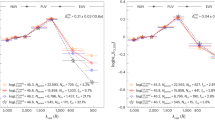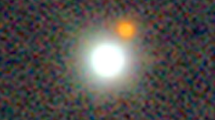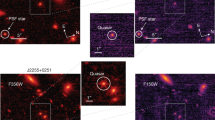Abstract
IT has been suggested recently1–4 that two classes of radio-loud extragalactic object, narrow-line radio galaxies and quasars, are intrinsically similar, differing only in the angle from which they are seen by the observer. In the simplest version of such models, one would expect that the [O III] 5,007-Å line luminosities of the two types of object would be similar for a given extended radio luminosity and redshift. In spectroscopic observations of a sample of radio galaxies and quasars selected so as to be otherwise comparable, we find that this is not the case: the quasar [O III] luminosities exceed those of radio galaxies by factors of 5–10. Extinction by at least two magnitudes as a result of orientation differences is necessary for these observations to remain consistent with the radio galaxy/quasar unification hypothesis; we suggest that evidence for such extinction may exist in the form of high Hα/Hβ ratios in radio galaxies5–8.
This is a preview of subscription content, access via your institution
Access options
Subscribe to this journal
Receive 51 print issues and online access
$199.00 per year
only $3.90 per issue
Buy this article
- Purchase on Springer Link
- Instant access to full article PDF
Prices may be subject to local taxes which are calculated during checkout
Similar content being viewed by others
References
Scheuer, P. A. G. in Superluminal Radio Sources (eds Zensus, J. A. & Pearson, T. J.) 104–113 (Cambridge University Press, 1987).
Morisawa, K. & Takahara, F. Mon. Not. R. astr. Soc. 228, 745–758 (1987).
Barthel, P. D. Astmphys. J. 336, 606–611 (1989).
Browne, I. W. A. in BL Lac Objects-10 Years After (eds Maraschi, L, Maccacaro. T, & Ulrich, M.-H.) 401–411 (Springer, Berlin, 1989).
Costero, R. & Osterbrock, D. E. Astrophys. J. 211, 675–683 (1977).
Koski, A. T. Astrophys. J. 223, 56–73 (1978).
Gaskell, C. M. Publs Astr. Soc. Pacif. 94, 891–893 (1984).
Ferland, G. J. & Osterbrock, D. E. Astrophys. J. 289, 105–108 (1985).
Blandford, R. D. & Königl, A. Astrophys. J. 232, 34–48 (1979).
Orr, M. J. L. & Browne, I. W. A. Mon. Not. R. astr. Soc. 200, 1067–1082 (1982).
Jackson, N., Browne, I. W. A., Murphy, D. W. & Saikia, D. J. Nature 338, 485–487 (1989).
Murphy, D. W. thesis, Manchester Univ. (1988).
Fanaroff, B. L. & Riley, J. M. Mon. Not. R. astr. Soc. 167, 31P–35P (1974).
Yee, H. K. C. Astmphys. J. 241, 894–902 (1980).
Laing, R. A., Riley, J. M. & Longair, M. S. Mon. Not. R. astr. Soc. 204, 151–187 (1983).
Saunders, R., Baldwin, J. E., Rawlings, S., Warner, P. J. & Miller, L. Mon. Not. R. astr. Soc. 238, 777–790 (1989).
Wills, B. & Browne, I. W. A. Astrophys. J. 302, 56–63 (1986).
Baum, S. A. & Heckman, T. M. Astrophys. J. 336, 702–721 (1989).
Osterbrock, D. E. Astrophysics of Gaseous Nebulae (Freeman, San Francisco, 1974).
Avrett, E. H. & Loeser, R. Astrophys. J. 331, 211–246 (1988).
Heckman, T. M., Miley, G. K. & Green, R. F. Astrophys. J. 281, 525–534 (1984).
de Waard, G. thesis, Univ. Leiden (1986).
Riley, J. M. & Pooley, G. G. Mem. R astr. Soc. 80, 105–137 (1975).
Kellermann, K. I., Pauliny-Toth, I. I. K. & Williams, P. J. S. Astrophys. J. 157, 1–34 (1969).
Browne, I. W. A. & Murphy, D. Mon. Not. R. astr. Soc. 226, 601–627 (1987).
Jenkins, C. J., Pooley, G. G. & Riley, J. M. Mem. R. astr. Soc. 84, 61–99 (1977).
Miley, G. K. & Hartsuijker, A. P. Astr. Astrophys. Suppl. 34, 129–163 (1978).
Kühr, H., Nauber, U., Pauliny-Toth, I. I. K. & Witzel, A. Max-Planck-lnstltut für Radioastronomie preprint no. 55 (1979).
Boroson, T. A. & Oke, J. B. Astrophys. J. 281, 535–544 (1984).
Rawlings, S. thesis, Univ. Cambridge (1987).
Owen, F. N. & Puschell, J. J. Astr. J. 89, 932–957 (1984).
Leahy, J. P. & Williams, A. G. Mon. Not. R. astr. Soc. 210, 929–951 (1984).
Macklin, J. T. Mon. Not. R. astr. Soc. 203, 147–155 (1983).
Feretti, L., Gioia, I. M., Giovannini, G., Gregorini, L. & Padrielli, L. Ast. Astmphys. 139, 50–54 (1984).
Author information
Authors and Affiliations
Rights and permissions
About this article
Cite this article
Jackson, N., Browne, I. Spectral differences between radio galaxies and quasars. Nature 343, 43–45 (1990). https://doi.org/10.1038/343043a0
Received:
Accepted:
Issue Date:
DOI: https://doi.org/10.1038/343043a0
This article is cited by
-
Radio AGN in the local universe: unification, triggering and evolution
The Astronomy and Astrophysics Review (2016)
-
Genomic Mining for Novel FADH2-Dependent Halogenases in Marine Sponge-Associated Microbial Consortia
Marine Biotechnology (2013)
-
Support for a unified model of radio galaxies and quasars from isotropic [OII] emission
Nature (1993)
Comments
By submitting a comment you agree to abide by our Terms and Community Guidelines. If you find something abusive or that does not comply with our terms or guidelines please flag it as inappropriate.



